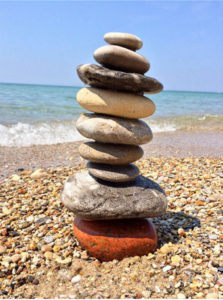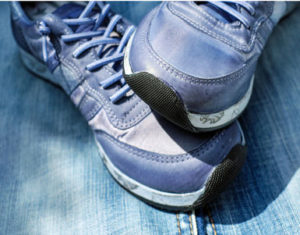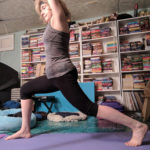 I recently had the privilege of interviewing Kathleen Cameron, MPH, Senior Director of the Center for Healthy Aging, part of the National Council on Aging (ncoa.org), about balance, falls, and health as we age.
I recently had the privilege of interviewing Kathleen Cameron, MPH, Senior Director of the Center for Healthy Aging, part of the National Council on Aging (ncoa.org), about balance, falls, and health as we age.
Kathy told me that older Americans’ falling is one of the most significant public problems today. It’s estimated that 25 to 33 percent of people over the age of 65 fall every year. About 25% of those who fall are injured. Most common are broken wrists or hips. Femur breaks are also common, even though the femur is one of the biggest bones in the body.
Falls are also the leading cause of traumatic brain injury, and can also exacerbate other problems to the point where the person never recovers, and may even die.
Falls certainly account for many trips to the emergency room, hospital stays and courses of rehabilitation. It’s estimated that falls have cost $31 billion every year.
A descending spiral
The fear of falling alone can restrict activities, although most falls occur at home. People become more isolated and fearful of leaving home, which can lead to depression.Those who suffer from depression can fall even more.
You can see the spiral here. A self-fulfilling prophecy. People fear falling so they don’t do the things which can prevent falls, which causes an increased risk of falling.
Good news
The good news is that many falls can be prevented. Staying active, starting as early in life as possible, can prevent falls. Regular exercise, including strength and balance work, also can prevent falls. (And people give me funny looks when I tell them about my balance work…)
Kathy says even entirely healthy people aged 60 and older are more prone to falls than those 10 to 20 years younger. Changes occur to the body in aging that contribute to falls. As we age, we tend to lose muscle mass and strength decreases. To counteract the effect, it’s even more important to combine strength exercises with our cardio and balance!
Pre-existing conditions
Many older Americans also suffer from chronic conditions – heart disease, arthritis, and diabetes – which also contribute to the risk. And medications that are prescribed for these conditions may have side-effects such as dizziness and drowsiness, which contribute to falls.
Once again, though, there is good news. If a healthy and fit 60-year-old does suffer a fall, his or her recovery may be easier than others’. I told Kathy about a recent fall of my own. I stepped on a rock funny in the dark, fell and skinned my shin. 2 weeks later, it’s all better except for a little scab. Kathy said that it’s probably due to the strength and balance work I do that my injuries were not worse and my recovery was so fast.
Practice helps!
Practicing balance truly does help to reduce the risk of falling. But it needs to be practiced on a regular basis – in fact, daily! Tai Chi is one example of exercise that improves strength and balance, but it must be practiced for at least 50 hours before it produces any benefits. Starting early will help later, but it’s never too late to start!
Yoga has not been studied specifically for reducing falls, but if you’re physically able to do it, it certainly can’t hurt. Balance and strength, which yoga improves, reduce the risk of falls.
Balance is a combination of many factors
Kathy said that balance combines many sensory inputs. Input from the eyes, ears, and touch are all integrated through the brain and output through the muscles. All of your senses combine to affect your balance.
Balance also has a psychological component which may be even more difficult to overcome. Fear of falling is a real problem for many. There is an evidence-based program, “A Matter of Balance,” that the National Council on Aging encourages, helps to overcome the psychological effect of the fear of falling. If you or someone you know has a fear of falling, I urge you to contact your local area Agency on Aging and take advantage of this program. Everyone should be able to enjoy the world as much as they want to!
Shoes make the woman (or man)
 Footwear makes a difference in balance. According to Kathy, high heels significantly increase the risk of falling – no surprise there. But going barefoot or in socks at home also increase the risk, due to a higher risk of slipping. Low-heeled shoes with firm, slip-resistant soles like rubber are recommended. And be sure to wear your glasses, even at home!
Footwear makes a difference in balance. According to Kathy, high heels significantly increase the risk of falling – no surprise there. But going barefoot or in socks at home also increase the risk, due to a higher risk of slipping. Low-heeled shoes with firm, slip-resistant soles like rubber are recommended. And be sure to wear your glasses, even at home!
Vision plays a very big role in balance. Everyone should have their vision checked every year, and have their corrective lenses adjusted. Your home should be properly lit. Don’t sit in the dark! If you can’t reach a burnt-out light bulb, ask for help. Don’t climb on things to change it! Have a clear, well-lit path from the bedroom to the bathroom. There are attractive modern switches that dim or light a path. Use one!
Weighty matters
The obesity epidemic in America is also a factor in falls. People who are obese may be less physically active, they may not be as strong and their balance may not be as good. Kathy said, many obese people who fall feel hopeless and helpless, feeling that nothing can be done for them. Again, increasing the risk of more falls.
Obese people suffer from diabetes and arthritis at a higher rate, which leads to more pain and discomfort, which limits their activity, and increases the number of prescription medicines they’re on, according to Kathy. Some of these medications’ side effects increase the risk of falling. Pain medicine, for example, produces side effects such as sleepiness and dizziness, leading to more falls. Obese people also tend to be more depressed. Anti-depressant medication also increases the risk of falls. More dark spirals.
Common medications may increase your risk
 Many older Americans are on some form of medication that contributes to falls. Kathy says that even some common prescriptions can increase your risk because they are psychoactive in nature and affect the central nervous system.
Many older Americans are on some form of medication that contributes to falls. Kathy says that even some common prescriptions can increase your risk because they are psychoactive in nature and affect the central nervous system.
Many opioid pain medications increase the risk. So do insomnia medications such as benzodiazepines, and blood pressure medication. As we get older, our bodies don’t flush out medicines as quickly as when we’re young. Dosage could be a factor that increases our risk of falling. Get your medications checked on a regular basis.
Get your orthostatic blood pressure checked – sitting versus standing. If there’s a significant drop when you stand up, that could be a problem in your medications or their dosage. Our bodies’ response to medication changes as we age.
Even over-the-counter medications can also increase your risk of falling. The active ingredient in Benadryl and other antihistamines can lower your blood pressure, causing you to be dizzy and fall. It’s also found in sleep medicine that you can buy over the counter. Non-sedating allergy medicines are recommended, especially for people over 60 and those with a higher risk of falling.
What to do
In terms of exercise, walking alone doesn’t reduce falls, Kathy says. Walking is certainly important for cardiac benefits, but it should be done in conjunction with strength and balance work. The CDC recommends 20 minutes or so of vigorous activity 4-5 times a week, and moderate- or high-intensity strength work 2 days a week that involve all muscle groups.
Before anyone starts an exercise program they should check with their doctor and start slowly. Set realistic goals and build slowly. If you haven’t exercised in the past, the “Stay Active and Independent For Life” (SAIL) program is good for older adults. Then progress to “EnhanceFitness” and “A Matter of Balance.” These are evidence-based programs and are promoted by the National Council on Aging.
On a personal note, I add balance work to my regular exercise, which combines cardio and strength work.
Draft your doctor to help
If you’ve been to the doctor and had a bone density test, and you’re fine – Kathy says don’t be complacent! Falls are caused by many factors. At your next visit, ask your doctor for a falls-risk screening and assessment. Be pro-active and know your risks. Less than half of older Americans talk to their doctors about falls and their risks, not realizing their doctors can help.
What’s our take-away?
Be active and stay active! Be sure to follow the CDC’s guidelines on exercise, and add strength and balance work to your regimen. Contact me for suggestions!
If you’re overweight and fall into the “obese” category, get physical and psychological support. We want you to be healthy!
 Talk to your doctor about fall prevention, especially if you have fallen, have a fear of falling, or feel unsteady on your feet.
Talk to your doctor about fall prevention, especially if you have fallen, have a fear of falling, or feel unsteady on your feet.
Have your prescriptions monitored for interactions and side-effects that contribute to falls.
Get your vision checked once a year and your corrective lenses adjusted accordingly.
And turn your lights on!
Wear safe shoes – there are some cute ones out there… I checked.
Join my Facebook Balance Community – Balance for Fitness, Balance for Life!
Be sure to subscribe to Fran’s newsletter for news, tips, recipes and (sometimes) fun stuff!
Stay in control of your falls risk. You have the power to prevent a fall!

